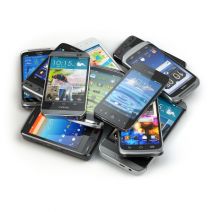With the smartphone market losing ground for the first time in its short history, many of the manufacturers you’ve come to know are either non-factors in the current market, or don’t even produce smartphones anymore. With new demand growing every year, new manufacturers such as OnePlus and Xiaomi are primed to fall in line behind Samsung and Apple.
With today’s devices changing only slightly over a year, demand for new devices has fallen off, taking the once robust smartphone market with it. Don’t think for a second that people are not in the market for good smartphones, they just don’t see how paying upwards of a $1,000 per year on top of their service contract is necessary when their devices will last two or three years.
If you are in the market for a new flagship smartphone, this is your list. We’ve put together a list of five of the best smartphones you can own right now. They are:
LG V40 ThinQ
The V40 ThinQ may have a weird name, but it works to solidify the foothold the V-series phones have as a major player in the flagship smartphone market. The newest handset features a bezel-less 6.4-inch, OLED display, but the major shift (as you’ll see on many of the smartphones nowadays) is the bevy of lenses found on the device.
By integrating a total of five lenses the V40 ThinQ gives the user a lot of options on how to capture images and video. It features two 12 MP lenses (one wide angle and one telephoto), and a 16 megapixel ultra-wide-angle lens on the back, as well as two separate front-facing lenses. Another interesting feature is the “triple-preview” that allows users to see which camera will work best for the shot they are framing. The LG V-40 ThinQ is available in New Platinum Gray, Carmine Red, New Aurora Black, and New Moroccan Blue and can be had for around $900.
Specifications
Build - Aluminum with Glass Front/Back
Display - 6.4” P-OLED with ~537 ppi
Chipset - Qualcomm Snapdragon 845
Memory - 6 GB RAM
Storage - 64/128GB, microSD up to 512GB
Software - Android 8.1 Oreo
Cameras - 12 MP (27mm) optical image stabilization; 12 MP (52mm) with 2x optical zoom and optical image stabilization; 16 MP (16mm); 8 MP (26mm) and 5 MP (21mm) front-facing.
Battery - 3,300 mAh (64 hours)
Additional Features - Rear-mounted fingerprint scanner
Samsung Galaxy Note 9
Samsung ships more smartphones than any other manufacturer, and for good reason, they tend to make the best phones. The Galaxy Note 9 is no different. With an octa-core Snapdragon 845, six or eight GB of RAM and 128 or 512 GB of onboard storage, the Note 9 matches up with about any handset available on the market. The device ships with Android 8.1 Oreo, but will be getting 9.0 Pie right along.
As far as the camera goes, it features two lenses, a 12 MP wide angle lens, and a 12 MP telephoto lens with optical zoom. The best-in-class battery checks in at 4,000 mAh and produces a robust 97 hours endurance rating. It has an onboard “S Pen” that provides a lot of additional functionality including remote control over many of the phone’s applications. It is available in Metallic Copper, Lavender Purple, Midnight Black, Ocean Blue, and Pure White, and carries a $1,100 price tag.
Specifications
Build - Aluminum with Glass Front/Back
Display - 6.4” Super AMOLED with ~516 ppi
Chipset - Qualcomm Snapdragon 845
Memory - 6 or 8 GB of RAM
Storage - 128 or 512 GB of onboard storage and microSD up to 512 GB
Software - Android 8.1 Oreo
Cameras - 12 MP (26mm); 12 MP (52mm) with 2x optical zoom; optical image stabilization; 8 MP front-facing
Battery - 4,000 mAh (97 hours)
Additional Features - Samsung S Pen, rear-mounted fingerprint scanner, iris scanner.
Huawei Mate 20 Pro
How is it that what might be the best phone on the market, may not be available through your wireless carrier? Huawei’s Mate 20 Pro is a fantastic device, but some believe that since the Chinese government is one of their major investors, that it may be just too risky to allow this device to be made available in America.
That doesn’t stop the Mate 20 Pro from being a powerhouse, however. It is built on an aluminum chassis and features a 6.4-inch AMOLED display with a Kirin 980 processor. Its camera has four lenses, a 40 MP fixed wide-angle lens, a 20 MP ultra-wide-angle lens, an 8 MP telephoto lens with 5x optical zoom, and a front-facing “selfie cam”. It also features an in-display fingerprint reader and Qi-charging. Better yet, it allows users to charge other Qi-enabled devices simply by stacking the devices. The Huawei Mate 20 Pro is available in Emerald Green, Midnight Blue, Twilight, Pink Gold, and Black and can be found for $1,100 on the Internet.
Specifications
Build - Aluminum frame with Glass Front/Back
Display - 6.4” AMOLED with ~538 ppi
Chipset - HiSilicon Kirin 980
Memory - 6/8GB RAM
Storage - 128/256GB with Nano Memory slot up to 256GB
Software - Android 9.0 Pie, Huawei UI
Cameras - 40 MP (27mm); 20 MP (16mm); 8 MP (80mm) with 5x optical zoom and optical image stabilization. Front facing 24 MP.
Battery - 4,200 mAh (85 hours)
Additional Features - Face ID, In-display fingerprint scanner, Qi wireless charging broadcasting, 40-Watt fast charging
Apple iPhone XS Max
A staple on many of these best-of lists for over a decade, the iPhone is smartphone royalty. This year’s option, the iPhone XS max gets a boost in power from Apple’s new A12 Bionic processor. It is said to improve the speed of the device up to 15 percent. The phone is built on a stainless-steel chassis and covered with premium glass. The phone’s display measures in at 6.5-inches.
The camera has two lenses: a 12 MP wide-angle lens, a 12 MP telephoto lens, and also features a 7 MP front-facing lens. With the enhancements made to iOS and the battery, the iPhone XS Max is again another standout product from Apple. It is available in Space Gray, Silver, and Gold, and can be had for $1,099.99 on any of the major carriers.
Specifications
Build - Stainless Steel with Glass Front/Back
Display - 6.5” Super AMOLED with ~458 ppi
Chipset - Apple A12 Bionic
Memory - 4GB RAM
Storage - 64/256/512 GB
Software - iOS 12/iOS 12.1
Cameras - 12 MP (26mm); 12 MP (52mm) with 2x optical zoom and optical image stabilization; 7 MP front-facing
Battery - 3,174 mAh (78 hours)
Additional Features - Face ID
Google Pixel 3 XL
Google’s phones haven’t always been thought of as premium. The Google Pixel and Pixel 2 models left something to be desired in build quality, but were known for having the best camera on a smartphone for each of the past two years. This time around the Google Pixel 3 has added glass front/back and a crystal-clear 6.3-inch OLED display. This year’s version feels more premium than any device the company has sponsored since the Google 6P, which was made by Huawei.
The Pixel 3 XL has a 6.3-inch OLED display and comes with what is widely regarded the best available camera on the market. The camera is 12.2 MP and excels in low light situations. The price of the Google Pixel 3 XL is at least $100 less than both the Samsung and Apple flagships, so it is more affordable for a premium device. It is available in colors White, Black, and Not Pink.
Specifications
Build - Aluminum with Glass Front/Back
Display - 6.3” P-OLED with ~523 ppi
Chipset - Qualcomm Snapdragon 845
Memory - 4GB RAM
Storage - 64/128GB
Software - Android 9.0 Pie
Cameras - 12.2 MP (28mm) with optical image stabilization
Battery - 3,430 mAh (69 hours)
Additional Features - Rear-mounted fingerprint scanner, squeeze to call Google Assistant, Call screen feature, Flip to quiet notifications
If you are looking for a smartphone to start the year off right, look no further than one of these five devices. What smartphone do you use? Leave your experiences in the comments section below and check back to The Connection, Inc’s blog for more great technology content.












